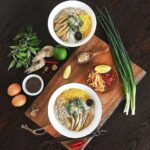From time immemorial, Thang Long has been a convergence point for various traditional crafts and exotic delicacies from different regions, creating a refined culinary culture that reflects the essence and embraces the extensive history of this land.
Many traditional dishes have become unforgettable memories for generations of Hanoians, those who are far from their hometown, and travelers to the capital. Today, the cuisine not only plays a crucial role in the economy but also stands as a unique intangible cultural heritage, acting as a “cultural ambassador” actively promoting the image of the capital to global friends.
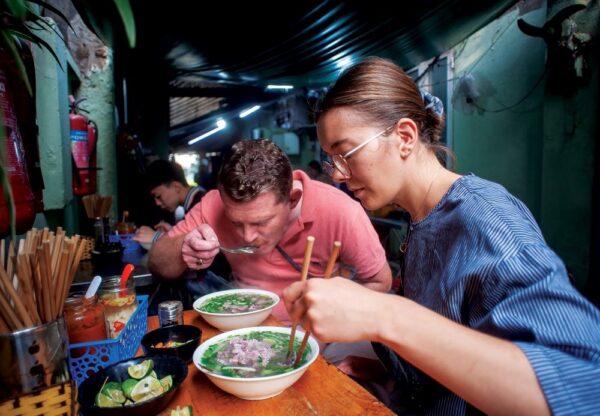
Foreign tourists enjoy Pho Thin Bo Ho. Photo by: Tran Bang
The “Cultural Ambassador” of Hanoi
Hanoi’s cuisine is not merely about delicious dishes; it also reflects the ingenuity and sophistication of the people in both appreciation and preparation. Many visitors to Hanoi, aside from sightseeing, spend a considerable amount of time savoring the renowned pho, La Vong fish cake, Hang Manh grilled pork with rice vermicelli, Thanh Tri steamed rolled pancake, and Co Am’s rice vermicelli soup, and leisurely enjoying a cup of rich egg coffee while admiring the Ancient Town.
On social media platforms, many foreigners have expressed their affection for Hanoi’s cuisine. A notable example is the handsome French Tiktoker, Will Courageux, owner of the “Will in Vietnam” account with over 3 million followers. Setting foot in Vietnam in 2014, Will was immediately captivated by Hanoi’s cuisine, prompting him to quit his IT engineer job in Sweden and settle in this S-shaped land. In his videos, he passionately showcases his love for pho, crab noodle soup, shrimp cakes, rolled cakes, pho rolls, coffee, and more. Will demonstrates a profound understanding of Hanoi’s cuisine, similar to a local. He takes friends, family, and even the French Ambassador to Vietnam, Olivier Brochet, to eateries in narrow alleys or food streets to help them discover Hanoi’s culinary delights.
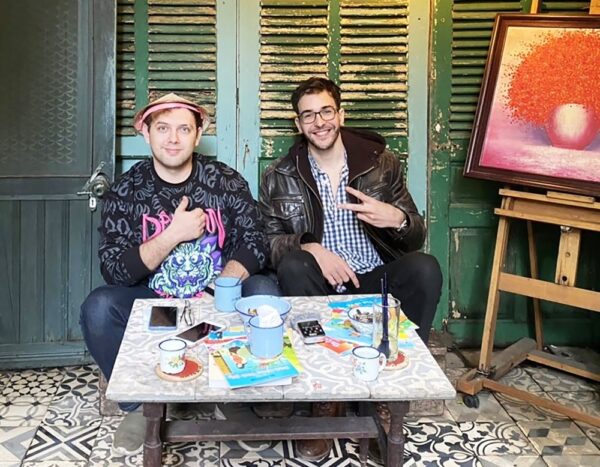
Two Tiktoker Will Courageux (right) and Peter Dgplv – foreign lover of Hanoi culture and cuisine. Photo by: VOV
In addition to Will, many other “hot TikTokers” express a special love for Hanoi’s cuisine, such as “Take Son” (Yamamoto Takehito from Japan), “Chiec Tay Valentin” (Valentin Constantinescu from Romania), and “Anh Nga Ngo” (Peter Dgplv from Russia). Watching their reviews of new dishes, a common thread emerges – an endless passion for Hanoi’s culture and cuisine. Most of them have forsaken their previous stable jobs to settle in Vietnam for the long term.
Hanoi’s cuisine not only captivates the younger generation but also establishes itself in the hearts of politicians, celebrities, and foreign CEOs. Recall the strong impression made by Pho Thin, Phu Thuong sticky rice, and Giang coffee on international dignitaries and the press during the second US-North Korea Summit in Hanoi (2019) or the visits of US President Barack Obama, Prince William of England. In 2023, Hanoi had the honor of hosting numerous important guests, each visit accompanied by culinary experiences. This included President of South Korea Yoon Suk-yeol and his wife savoring pho at a restaurant on Le Thai To Street (June 2023), and Prime Minister of Belarus Golovchenko and Prime Minister Pham Minh Chinh enjoying bread, and Vietnamese coffee near the Hanoi Flagpole (December 2023).
A recent buzz on the internet for the past few days is the images of Nvidia Corporation’s billionaire CEO Jensen Huang during his visit to Vietnam, indulging in steamed snails, spring rolls, beef pho, egg coffee, and coconut water in just one evening, right after landing. These images make Hanoi residents proud of their city, one that is safe, friendly, and enticing.
The Story of Hanoi’s Culinary Brands
Explaining the allure of Hanoi’s cuisine, many international tourists believe that these dishes not only have a high level of internationalization, spreading worldwide but also maintain a distinctive identity, unlike dishes from other countries.
According to culinary artisan Pham Thi Anh Tuyet, Hanoi’s dishes attract people due to the balance of nutritional elements, a focus on health benefits, intricate ingredient selection, and the delicate preparation methods that preserve the distinctive taste of traditional cuisine. The dining style of Hanoians has its own unique flair, creating a special flavor with a slow and leisurely approach to fully experience the taste of the food.
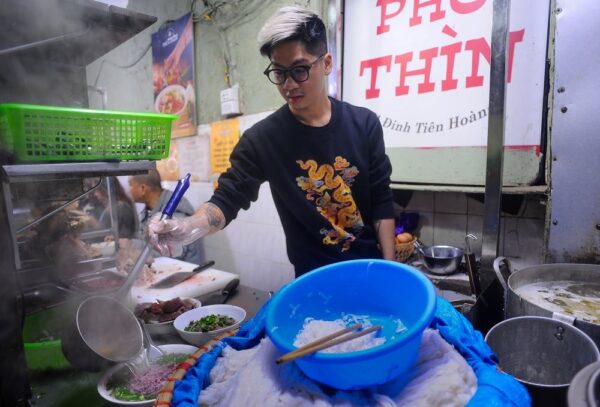
The third generation continues to preserve and develop the Pho Thin Bo Ho brand. Photo by: Tran Bang
Hanoians not only exhibit sophistication and refinement in the preparation of their dishes but also place significant emphasis on preserving the traditional flavors, considering it the ancestral secret for survival across generations. This is the philosophy embraced by Mr. Bui Chi Thanh, the grandson of Mr. Thin, the proprietor of Pho Thin Bo Ho, who continues the legacy.
Mr. Thanh shares, “Hanoi’s pho distinguishes itself in flavor and appreciation from elsewhere. Unlike pho from Nam Dinh, Hanoi’s pho uses fresh ginger to enhance the taste instead of star anise, cinnamon, and cardamom. Simultaneously, there is a need for a technique in handling bones and beef to mask any unpleasant odor, ensuring that the broth remains clear, refined, and preserves the original taste of the ingredients. The greatest value of Pho Thin lies not only in its quality but also in the trust of customers and the heritage passed down through generations.”
Today, when mentioning Hanoi’s coffee, it’s not just domestic tourists but also many international visitors who are greatly impressed by the famous egg coffee and the brand Giang Coffee. However, several decades ago, Hanoians were familiar with Nhan coffee (located on Hang Hanh Street), a place with a history intertwined with an interesting story. Established in 1946, initially named “Biet dong doi Coffee,” the owner was Mr. Nguyen Van Thi, a former member of the Special Forces Unit 3 (Hoang Dieu Special Forces). In 1946, due to political reasons, his family moved to Van Dinh. Following a superior’s suggestion, Mr. Thi, along with two friends, Mr. The and Mr. Nhan, opened a coffee shop. This served both as a means to support their families and as a meeting place for revolutionaries. They procured fresh coffee beans and experimented with blending tea and roasted coffee beans, creating a “secret” ratio that produced a distinctive flavor. Since then, the Nhan coffee brand has endured and thrived as a “historical witness” of Hanoi’s culinary landscape.
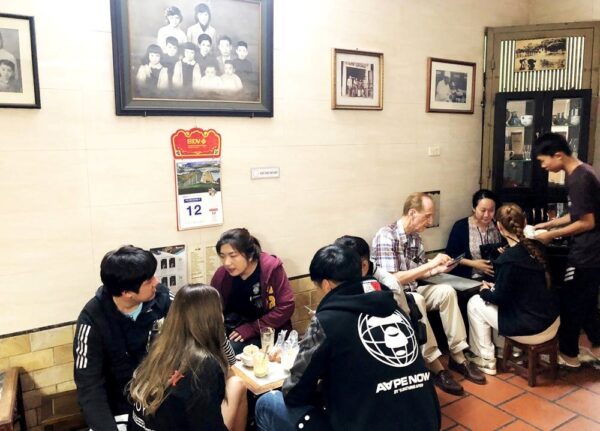
Young people and foreign tourists enjoy Giang coffee. Photo: Linh Tam
Elevating Heritage and Advancing Culinary Tourism
Currently, cuisine is becoming a competitive advantage and a crucial factor in building the brand of a country or destination. Recognizing the essence of cuisine and honoring it through the lens of intangible cultural heritage contributes to the distinctiveness of a destination. This is a lesson learned by several countries worldwide, such as the beer culture in Belgium, the kimchi culture in South Korea, and the coffee culture in Turkey, all recognized by UNESCO as representatives of human intangible cultural heritage. It serves as a “tool” to preserve traditional values, encourage creativity, and develop culinary tourism destinations.
Realizing the importance of making cuisine part of the intangible cultural heritage, the People’s Committee of Hoan Kiem District recently formulated the project “Development and Promotion of the Culinary Cultural Heritage of Hoan Kiem District for Tourism Development until 2025.” Based on the criteria stipulated in Article 10, Circular 04/2010/TT-BVHTTDL issued on June 30, 2010, Hoan Kiem District identified three cultural heritages that meet the criteria for submission to the national intangible cultural heritage list. These are the coffee culture in Hanoi’s Ancient Town, the art of cooking and enjoying “bun thang” (a special kind of rice vermicelli soup) in Hanoi’s Ancient Town, and the knowledge of making “cha ca” (grilled fish) in Hanoi’s Ancient Town.
According to the Chairman of the People’s Committee of Hoan Kiem District, Pham Tuan Long, the main purpose of the project is to recognize the value of culinary cultural heritage and develop measures to leverage this heritage for the economic and tourism development of Hoan Kiem District in the coming years.
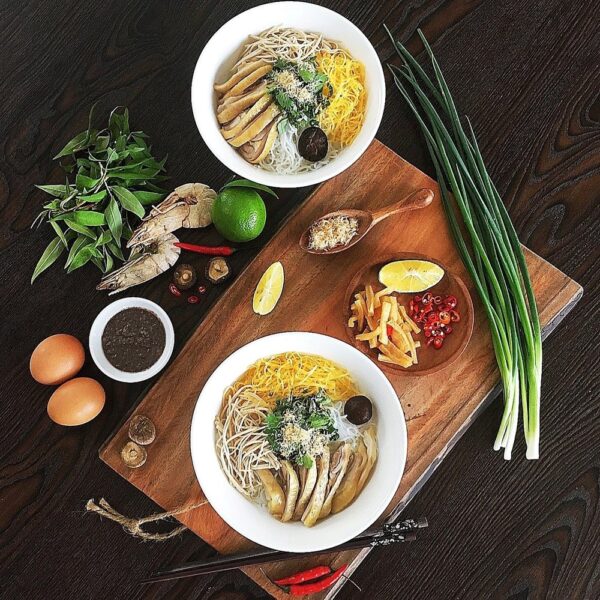
Co Am’s rice vermicelli soup – one of the unique dishes of Hanoi brand. Photo by: Nhat Anh
Another delightful news for Hanoi’s cuisine is that the Hanoi Department of Culture and Sports is expediting the documentation process so that by 2024, “Hanoi pho” and “Phu Thuong sticky rice” will be included in the national intangible cultural heritage list. This recognition aims to honor the distinctive dishes of Hanoi, acknowledging their contributions to preserving and conserving folk knowledge held by artisans and communities. It is a way for Hanoi’s cuisine to establish its position on the Vietnamese culinary map and contribute to the overall development of the capital city.
Linh Tam
Định vị thương hiệu Thủ đô bằng di sản văn hóa ẩm thực: Nâng tầm ẩm thực Hà thành (hanoimoi.vn)

